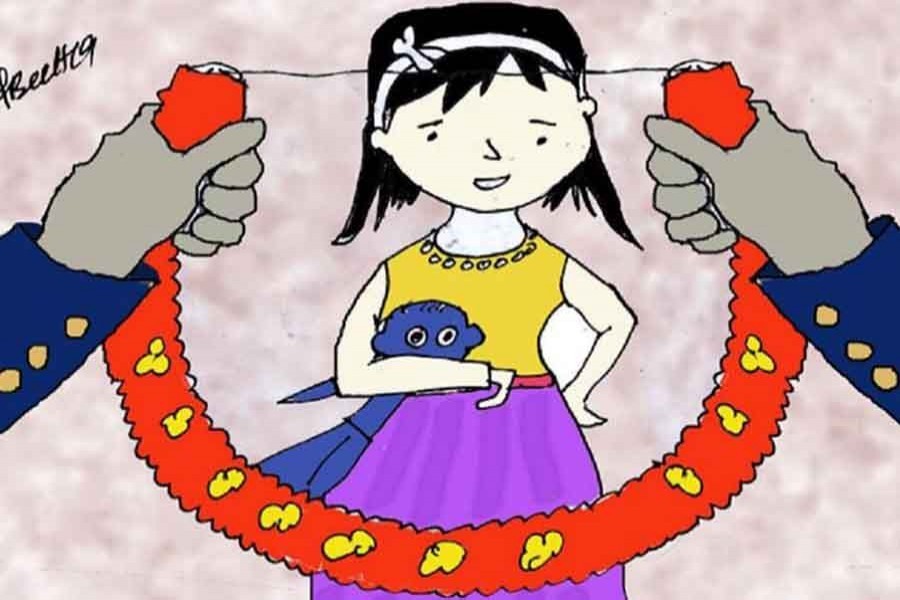UNICEF has released a report in October on the state of child marriage in Bangladesh, which provides a grim picture of this pervasive social malaise in the country despite progress in recent decades. Titled 'Ending Child Marriage: A Profile of Progress in Bangladesh', it claims based on countrywide surveys that Bangladesh is home to 38 million child brides. They include the currently married girls and those who were married off during their childhood before the age of 18 years. Astonishingly, 13 million among them were married even before their 15th birthday. And 51 percent women in the age-group of 20-24 years were married before their 18th birthday. The UNICEF report however notes that the trend of child marriage has declined in the country by over 90 percent compared to the 1970s.
The present government in Bangladesh aims to achieve the target of drastically reducing child marriage by 2030 in line with the Sustainable Development Goals (SDGs), and plans to eliminate it altogether by 2041 as a national objective. But the rate of progress has to be increased eightfold if the national goal is to be attained, and 17 times if the SDG target is to be met. Notably, the JatiyaSangsad passed the 'Child Marriage Restraint Act, 2017' in 2017, and the government hopes to bring down the rate of child marriage through its rigorous enforcement, especially in rural areas.
According to the UNICEF report, Nigeria has the highest rate of child marriage in the world followed by Niger, Central African Republic, Chad, Mali, Mozambique, Burkina Faso, South Sudan, Bangladesh, Guyana and Somalia. Bangladesh is ranked 8th among the top 10 countries having highest rates of child marriage in the globe. In South Asia region, Bangladesh has the worth ranking in the area, and this standing has remained consistent over a long period.
The UNICEF report has pointed out certain features of child brides in Bangladesh. For example, they mostly reside in rural areas and poorer households, and are less likely to progress beyond secondary education. They are over four times likely to be out of school compared to unmarried girls; about half of them give birth before the age of 18, and 80 percent become mothers before reaching the age of 20. However, the prevalence of child marriage before the age of 18 has dropped from about 90 percent in 1970 to just over 50 percent today.
Some interesting findings of UNICEF with regard to current levels of child marriage are as follows: in many districts like Chapainawabganj, Narail, Naogaon, Rajshahi, Bagerhat, Bogura, Tangail, Cumilla and Mymensingh, a majority of women were married during childhood; child marriage declines among those having minimum 10 years of schooling, and its prevalence falls below 50 percent among those with minimum 12 years' schooling; girls beyond secondary schools are least likely to become child brides even when they live in poorer households and reside in rural areas. Besides, nearly one-third child brides have a spouse who is at least 10 years older, compared to one-fourth of young women who marries during adulthood; child brides go on to have somewhat larger families than those who marry in adulthood; and married girls are over four times likely to be out of school compared to unmarried ones.
Wherever it may be practiced, child marriage is undoubtedly a violation of human rights. In fact, marriage before adulthood is a breach of children's right regardless of their gender. All children deserve to be protected from this malady, as it can have devastating effects for individuals and societies. The Target-5.3 of the SDGs aims to eliminate this harmful practice by the year 2030. Besides, child marriage has a negative impact on the realization of other SDGs related to education, health and wellbeing. The specific power dimensions and negative gender norms for girls should therefore be taken into cognizance for the progressive attainment of their human rights.
Reducing and ending child marriage is now a priority for both the Government of Bangladesh as well as the country's development partners, as both the parties acknowledge the need for preserving childhoods, securing children's rights to life and education, reducing their exposure to violence and exploitation, and making contribution towards elimination of inter-generational poverty. The Child Marriage Restraint Act, 2017 and the National Plan of Action to End Child Marriage (2018-19) adopted by the Government of Bangladesh spell out the steps that should be taken for realizing these goals.
Bangladesh is also being covered by the UNFPA-UNICEF Global Programme to Accelerate Action to End Child Marriage. The objective of this programme is to realign the prevalent social norms and ease structural causes of gender inequality, so that girls are free from the risk of child marriage through wider life options granted to them. The programme contributes to the National Plan of Action of Bangladesh for ending child marriage, and is linked to its five pillars: sector-based policies; legal reform and accountability; positive social values and norms; empowerment of adolescent girls; and their social protection systems. Subsequently, the programme will expand by targeting the most marginalised and hard-to-reach girls. It will focus on strengthening systems and increasing government ownership by translating policies and laws at the sub-national level, providing better monitoring cum accountability, and building stronger partnerships with the civil society and NGOs.
The broad evidence-based strategies being pursued by the programme are as follows: enhancing the agency and voice of adolescent girls; investing in and supporting adolescent girls through community engagement and positive behaviour; increasing resources and opportunities for adolescent girls; strengthening legislative and policy frameworks to protect and promote their rights; and generating as well as using robust data cum evidence for gauging progress.
The established social customs and policies that support child marriage should therefore be continuously challenged, and investments should be significantly enhanced for improving the health, wellbeing and education of girls in order to protect them from undue repression and violence including untimely marriages.
Dr Helal Uddin Ahmed is a retired Additional Secretary and former Editor of Bangladesh Quarterly.


